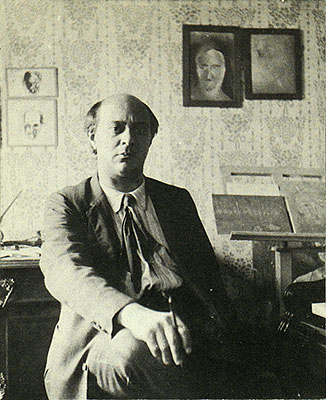We eased back into our Challenge this week like an elephant eases into a teacup. This week’s reading covered almost all of Taruskin’s chapter on the early life and work of Arnold Schoenberg, a composer whose opaqueness is famous, and well known in his own day: Schoenberg’s disciple Alban Berg wrote an article called “Why Is Schoenberg’s Music So Difficult to Understand?” in honor of his teacher’s fiftieth birthday (IV, 324). Taruskin’s discussion of Schoenberg’s music includes the opera Erwartung (Op. 17), the art song Mädchenlied (Op. 6, no. 3), Sechs kleine Klavierstücke (“Six Little Pieces for Piano,” Op. 19, no. 1), “Vorgefühle” (“Premonitions”) from Five Orchestral Pieces (op. 16), and the unfinished oratorio Die Jakobsleiter. The analyses, which are written in a style considerate of the reader, are still heady and dense enough to give the undergraduate music student—not to mention the intelligent general reader—pause.
Indeed, for many music students, the real question is not Berg’s “why so difficult to understand?” but “why should we try to understand Schoenberg’s music in the first place?” Taruskin offers a compelling answer by linking Schoenberg’s technical developments, the realm of the mind, to his vision of transcendence, the realm of the elevated soul. Rather than being merely a set of mathematical exercises (a common blanket attack leveled at “atonal music” without regard to its accuracy or chronological appropriateness) that negated the spiritual aims of Romanticism, Taruskin argues that Schoenberg was taking transcendence to new extremes (Taruskin uses the term “maximalism”).

This chapter is the final piece of Taruskin’s trilogy of transcendentalism (chapters 4-6), in which he sets forth a major rethinking of the traditionally held division between the Romantic and Modernist periods in musical history. One of its major results is to revise the core definition of what comprises Romanticism—namely, that transcendence, rather than harmonic practice, is the Romantic trump card.
This runs directly in contrast to traditional understandings of the divisions between Romantic and Modernist periods, which are usually cast in technical terms: extreme chromaticism gave way to “atonality” and the final vestiges of common-practice harmony were eradicated, ushering in the new age. The example of this narrative I happen to have on my nearby shelf at the moment is Robert P. Morgan’s textbook, Twentieth-Century Music.* His analysis of Erwartung forms an apt comparison to Taruskin’s. Whereas a description of the plot is something of an afterthought in Morgan’s, second to Schoenberg’s compositional technique, it comes up front in Taruskin’s, framing the entire discussion. In Morgan’s, Erwartung is the clarion call of something new: “With its vivid suggestion of impending disaster and emotional disintegration, it is a true child of the new age” (73, emphasis added). In Taruskin’s narrative, Erwartung is driving toward a climax of pathos, the last gasp of the historical stream of Romanticism. As Taruskin will go on to argue in chapter 8, the “real” twentieth century didn’t begin at the fin de siècle, but in the 1920s when composers like Stravinsky sought to eradicate not Romantic harmonic practice, but Romantic subjectivity.
I, for one, will continue chunking through Taruskin’s text with one of Schoenberg’s (Taruskin’s?) lessons ringing in my ears: transcendence ain’t easy, but it’s worth it.
*Robert P. Morgan, Twentieth-Century Music: A History of Musical Style in Modern Europe and America (New York: WW Norton & Company, 1991).
I rather liked Taruskin’s take on early Schoenberg. My own master’s thesis demonstrated a strong link between harmonic progressions common in late Romantic music (including Schoenberg’s tonal works) and harmonic progressions in Schoenberg’s early atonal works–the same neo-Riemannian processes are occurring, and Schoenberg has merely started using non-triadic structures (and his favorite set classes have distinct ties to structures found in chromatic tonal music). Schoenberg himself describes composing during this time period as feeling his way instinctively, with rules there that he cannot yet understand himself. The shift into “objectivity” occurs for Schoenberg when he creates his twelve-tone system.
“As Taruskin will go on to argue in chapter 8, the “real” twentieth century didn’t begin at the fin de siècle, but in the 1920s when composers like Stravinsky sought to eradicate not Romantic harmonic practice, but Romantic subjectivity.”
I can’t necessarily converse about this topic as an apt historian of music. But as an appreciator of literature and music it seems to me like there aren’t any really distinct chronological boundaries between the different art periods. Would it be more fair to say that Schoenberg “bridged the gap” between late 19th century romanticism and “real” twentieth century?
Thanks for the comments Matt and Nathan.
Matt: You’re absolutely right to be skeptical of periodization of history, and the problems of this has been a subject already on this blog (search for the post “The Murky Meaning of Renaissance”). It’s good to bring it up again. Taruskin is being a bit tongue-in-cheek here—well aware that most periodization is done by historians after the fact, he’s working on the level of historiography here. That said, however, if ever there were a group of composers who were aware of their (desired) historical significance, it would be Schoenberg, Stravinsky, and others in this generation. Others preceded them (I’m looking at you, Wagner), but the early twentieth century was the age of artistic manifestos.